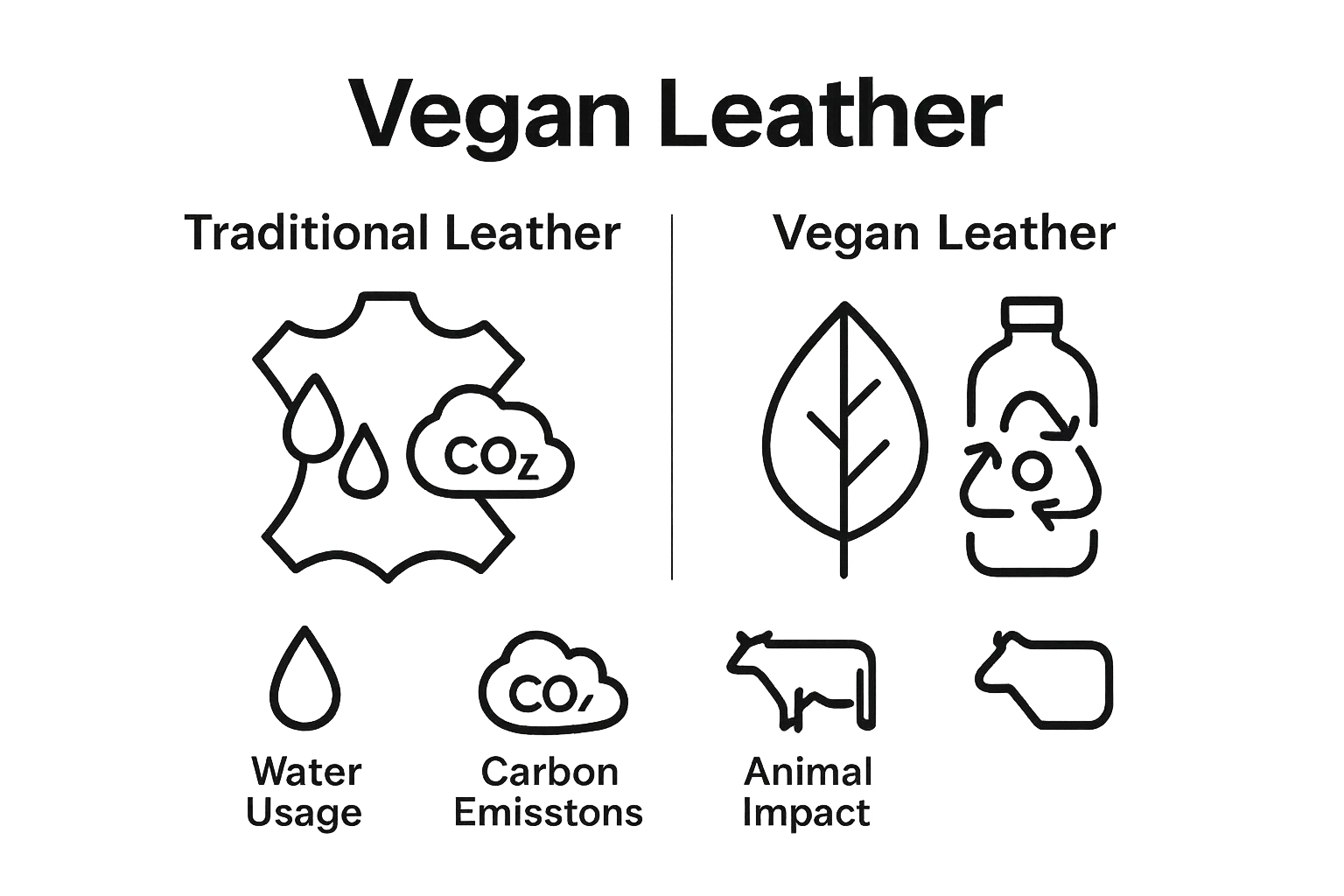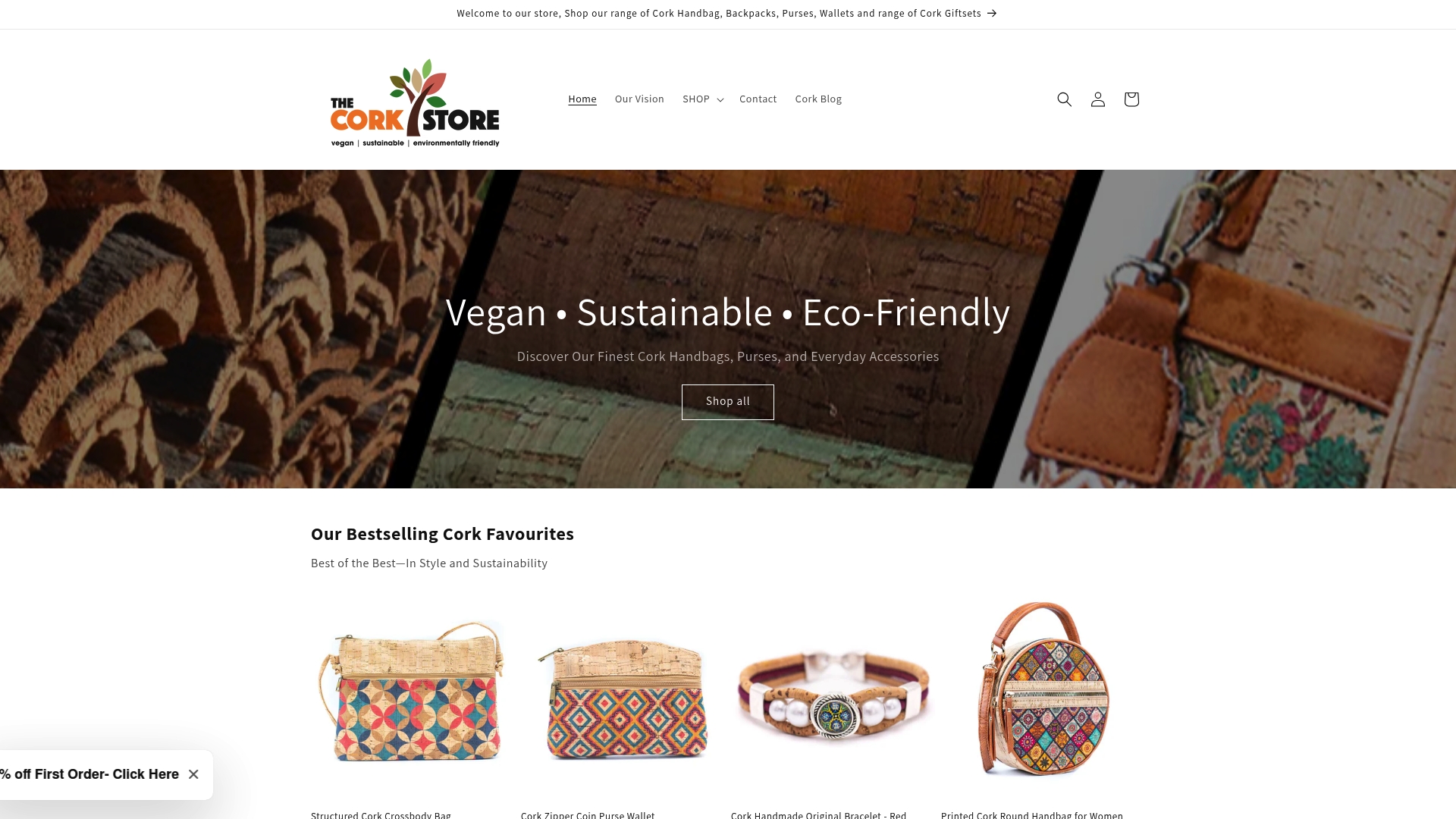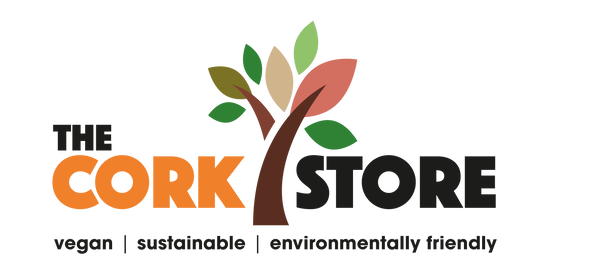
What is Vegan Leather? Understanding Its Impact
Share
Vegan leather is changing the way we think about fashion. While most people picture it as just a plastic substitute, the truth is far more surprising. Plant-based vegan leathers like cork and pineapple leaf fibre are now transforming agricultural waste into luxury materials, with the fashion industry producing about 10 percent of global carbon emissions. Forget what you know about faux leather and get ready to discover a world where style and sustainability walk side by side.
Table of Contents
- Defining Vegan Leather: Materials And Composition
- The Importance Of Vegan Leather In Sustainable Fashion
- How Vegan Leather Is Made: Production Processes Explained
- Comparing Vegan Leather To Traditional Leather
- Future Trends And Innovations In Vegan Leather
Quick Summary
| Takeaway | Explanation |
|---|---|
| Vegan leather is made from diverse materials. | It includes synthetic options like PU and PVC, and natural resources such as pineapple leaves and cork. |
| Plant-based vegan leathers are more sustainable. | Materials like mushroom mycelium and agricultural waste reduce environmental strain compared to petroleum-derived alternatives. |
| Vegan leather supports ethical fashion choices. | This material eliminates animal suffering and significantly lowers carbon emissions in the fashion industry. |
| Technological innovations are transforming production. | Advanced techniques from organic sources are leading to new vegan leather alternatives, enhancing functionality and sustainability. |
| Consumer demand drives vegan leather market growth. | As awareness of ethical consumerism rises, more people are seeking cruelty-free and environmentally responsible products. |
Defining Vegan Leather: Materials and Composition
Vegan leather represents an innovative alternative to traditional animal-derived leather, crafted entirely from synthetic or plant-based materials that eliminate animal exploitation. Explore our guide on sustainable vegan bags to understand the broader context of ethical fashion choices.
The Core Components of Vegan Leather
Unlike traditional leather sourced from animal hide, vegan leather encompasses a diverse range of materials engineered to mimic leather’s durability, texture, and aesthetic appeal. The primary materials used in vegan leather production include:
- Polyurethane (PU): A synthetic plastic polymer that provides flexibility and water resistance
- Polyvinyl chloride (PVC): Another plastic-based material known for its durability
- Plant-derived materials like cork, pineapple leaves (Piñatex), apple peels, and mushroom mycelium
- Recycled plastic materials transformed into leather-like textiles
Manufacturing Process and Sustainability Considerations
The production of vegan leather involves complex manufacturing techniques that transform raw materials into versatile, leather-like fabrics. According to research from the Sustainable Materials Institute, the environmental impact of vegan leather varies significantly depending on the source material and production methods.
While some synthetic vegan leathers derived from petroleum-based plastics can have substantial carbon footprints, plant-based alternatives offer more sustainable solutions. Materials like cork and pineapple leather demonstrate remarkable potential for reducing environmental strain by utilising agricultural waste and creating circular economy opportunities.
The goal of vegan leather is not just animal welfare but also developing materials that are environmentally responsible, aesthetically pleasing, and functionally comparable to traditional leather. By continuously innovating material compositions and manufacturing processes, designers and researchers are pushing the boundaries of sustainable textile production.
The table below provides an overview of the core materials used to produce vegan leather, along with their primary source and notable sustainability considerations.
| Material | Source Type | Example Source | Sustainability Considerations |
|---|---|---|---|
| Polyurethane (PU) | Synthetic | Petroleum-based | Petroleum-derived, but less toxic than PVC; recyclable in some contexts |
| Polyvinyl chloride (PVC) | Synthetic | Petroleum-based | High environmental impact; contains chlorine and additives |
| Cork | Plant-based | Cork oak bark | Renewable, biodegradable; harvested without killing the tree |
| Pineapple leaves | Plant-based | Pineapple agriculture | Utilises agricultural waste; reduces landfill |
| Apple peels | Plant-based | Food industry waste | Repurposes food-processing waste; lower environmental impact |
| Mushroom mycelium | Plant-based | Fungal root structures | Grown on organic substrate; compostable and renewable |
| Recycled plastics | Recycled/synthetic | Bottles, packaging | Diverts plastic from landfill; varies according to processing methods |
The Importance of Vegan Leather in Sustainable Fashion
Vegan leather has emerged as a transformative force in the fashion industry, challenging traditional manufacturing practices and offering ethical alternatives that prioritise environmental responsibility and animal welfare. Learn more about eco-friendly vegan handbags to explore sustainable fashion choices.
Ethical and Environmental Impact
The fashion industry has long been criticised for its significant environmental footprint and reliance on animal-derived materials. Vegan leather represents a critical solution to these challenges by providing cruelty-free alternatives that dramatically reduce animal suffering. According to Global Fashion Agenda research, the fashion sector accounts for approximately 10% of global carbon emissions, with leather production being a substantial contributor.
Key environmental benefits of vegan leather include:
- Elimination of animal slaughter for fashion purposes
- Reduced water consumption compared to traditional leather production
- Lower greenhouse gas emissions
- Utilisation of renewable and recycled materials
Economic and Innovation Potential
Beyond environmental considerations, vegan leather represents a significant economic opportunity for designers, manufacturers, and entrepreneurs. The material drives innovation by encouraging the development of novel textiles from unexpected sources like agricultural waste, mushroom mycelium, and recycled plastics.
This approach not only creates new economic value but also addresses multiple sustainable development goals by transforming waste streams into valuable fashion materials. The market for vegan leather continues to expand, with consumers increasingly demanding products that align with their ethical and environmental values.
The future of fashion lies in materials that are not just aesthetically pleasing but also responsible, demonstrating that style and sustainability can coexist harmoniously.

How Vegan Leather is Made: Production Processes Explained
Vegan leather production involves sophisticated manufacturing techniques that transform diverse raw materials into versatile, leather-like textiles. Learn more about cork leather innovations to understand unique material transformations.
Synthetic Material Production
Synthetic vegan leathers predominantly utilise petroleum-based polymers like polyurethane (PU) and polyvinyl chloride (PVC). According to sustainable textile research, these materials undergo complex processing stages:
- Polymer mixture preparation with specific chemical additives
- Coating textile backing with polymer layers
- Texturing and embossing to create leather-like surface patterns
- Heat treatment for durability and flexibility
Plant-Based and Innovative Material Techniques
Innovative vegan leather production increasingly focuses on transforming agricultural waste and organic materials into sustainable textiles. Cutting-edge techniques involve processing materials like pineapple leaves, apple peels, and mushroom mycelium through intricate mechanical and chemical processes.
Key steps in plant-based vegan leather production include extracting fibrous material, treating it with natural binders, compressing into sheets, and applying finishing treatments to enhance durability and aesthetic appeal.
These methods not only reduce environmental impact but also create valuable economic opportunities by repurposing agricultural byproducts.
The evolution of vegan leather production represents a remarkable intersection of technological innovation, environmental responsibility, and creative material science, continuously pushing boundaries of sustainable textile manufacturing.
Comparing Vegan Leather to Traditional Leather
The comparison between vegan leather and traditional leather reveals significant differences in production methods, environmental impact, and ethical considerations. Explore our guide on vegan purse features to understand the practical implications of these material choices.
Performance and Durability Characteristics
Traditional leather has long been prized for its natural durability, breathability, and ability to age gracefully. In contrast, vegan leather offers diverse performance characteristics depending on its base material. Research from materials science indicates that synthetic and plant-based vegan leathers demonstrate varying levels of resilience:
- Synthetic vegan leathers often provide water resistance and easier maintenance
- Plant-based alternatives like cork and pineapple leather offer unique texture variations
- Traditional leather typically ages with a patina, while most vegan leathers maintain consistent appearance
Ethical and Environmental Considerations
The fundamental distinction between traditional and vegan leather lies in their production philosophy. Traditional leather requires animal slaughter and involves complex tanning processes that generate substantial environmental waste. Vegan leather, by contrast, represents a conscious effort to eliminate animal suffering and reduce ecological footprint.
Environmental impact varies significantly across different vegan leather types. While some petroleum-based synthetic leathers may have high carbon emissions, innovative plant-based materials like mushroom leather and cork provide genuinely sustainable alternatives. These materials transform agricultural waste into valuable textiles, creating circular economic models that traditional leather production cannot match.

Ultimately, the choice between vegan and traditional leather reflects broader values of sustainability, animal welfare, and environmental responsibility. As technological innovations continue to improve vegan leather’s quality and performance, consumers increasingly recognise these materials as sophisticated, ethical alternatives to conventional leather.
To clarify the differences and similarities between vegan leather and traditional leather, the following table compares their key characteristics, advantages, and drawbacks.
| Feature/Characteristic | Vegan Leather | Traditional Leather |
|---|---|---|
| Source Material | Synthetic polymers (PU, PVC), plant-based (cork, pineapple leaves) | Animal hides (usually cow, sheep, or goat) |
| Animal Welfare | No animal exploitation involved | Requires animal slaughter |
| Environmental Impact | Varies: lower for plant-based, higher for petroleum-based | High: water use, pollution, greenhouse gases |
| Durability/Ageing | Varies: often less patina, consistent look | Ages with unique patina, generally highly durable |
| Maintenance | Easier maintenance, often water-resistant | Requires care products to maintain quality |
| Innovation Potential | High: ongoing development of new materials and techniques | Limited scope for innovation beyond tanning methods |
| Sustainable Options | Yes, especially plant-based or recycled varieties | Not inherently sustainable |
Future Trends and Innovations in Vegan Leather
The vegan leather landscape is rapidly evolving, driven by technological advancements, environmental consciousness, and consumer demand for sustainable alternatives. Explore our guide on understanding cork leather to discover innovative material transformations.
Biotechnology and Advanced Material Development
Cutting-edge biotechnology is revolutionising vegan leather production by developing materials from unexpected organic sources. According to scientific research in sustainable materials, emerging innovations include:
- Mycelium-based leather derived from fungal root structures
- Leather alternatives grown from bacterial cellulose
- Protein-based materials synthesised through advanced fermentation techniques
- Algae and seaweed-derived textile technologies
Circular Economy and Waste Transformation
Innovative vegan leather production increasingly focuses on transforming waste streams into valuable textile resources. Researchers and designers are developing techniques to convert agricultural byproducts, industrial waste, and recycled materials into high-performance leather alternatives.
Key strategies include developing leather-like materials from:
- Pineapple leaf fibres (Piñatex)
- Apple skin and core waste
- Recycled plastic bottles
- Coffee ground composites
- Fruit and vegetable processing remnants
These approaches not only reduce environmental waste but also create economic opportunities by reimagining waste as a valuable resource. The future of vegan leather lies in creating materials that are not just cruelty-free, but also regenerative and environmentally restorative.
Ready to Make a Real Difference With Your Accessories?
If you have been inspired by the truth about vegan leather and its impact, you understand the challenge of finding handbags, purses, or wallets that truly respect animal welfare and protect our planet. The article covered how traditional leather harms both animals and the environment, and revealed how innovations like cork-based vegan leather can help you make more ethical, sustainable choices.

Now is the perfect time to put your values into action. Whether you seek durability, unique style, or a genuinely eco-friendly alternative, you will find carefully crafted solutions at The Cork Store. Each product is proof that you do not need to compromise on quality or beauty for the sake of sustainability. Explore our range of eco-conscious cork accessories, from handbags and wallets to innovative gift sets, and join a growing movement towards ethical fashion today. Experience the transformation for yourself and shop at The Cork Store – discover accessories that look good, feel good, and do good. The difference starts with your next choice.
Frequently Asked Questions
What materials are used to make vegan leather?
Vegan leather is made from a variety of materials including synthetic polymers like polyurethane (PU) and polyvinyl chloride (PVC), as well as plant-based materials such as cork, pineapple leaves (Piñatex), apple peels, and mushroom mycelium. Some vegan leathers also incorporate recycled plastic materials.
How does vegan leather compare to traditional leather in terms of durability?
While traditional leather is known for its natural durability and unique ageing process, vegan leather can vary in performance. Synthetic vegan leathers often offer water resistance and easier maintenance, whereas plant-based alternatives may provide unique texture variations but generally do not develop a patina like traditional leather.
What are the environmental benefits of using vegan leather?
Vegan leather eliminates the need for animal slaughter and significantly reduces water consumption and greenhouse gas emissions compared to traditional leather production. Many vegan leathers made from plant-based materials also utilise agricultural waste, contributing to a more sustainable and circular economy.
Is vegan leather a sustainable choice?
Vegan leather can be a sustainable option, particularly if it is made from plant-based or recycled materials. However, some synthetic versions derived from petroleum-based sources can have a higher carbon footprint. Choosing plant-based alternatives can enhance the sustainability of vegan leather products.
